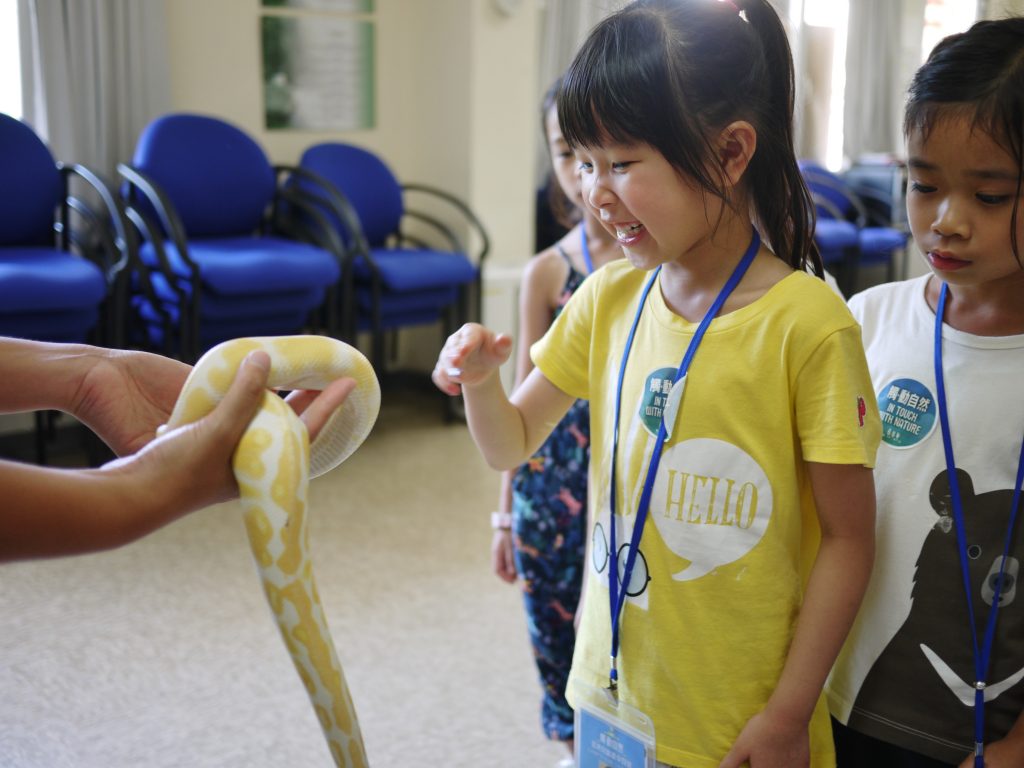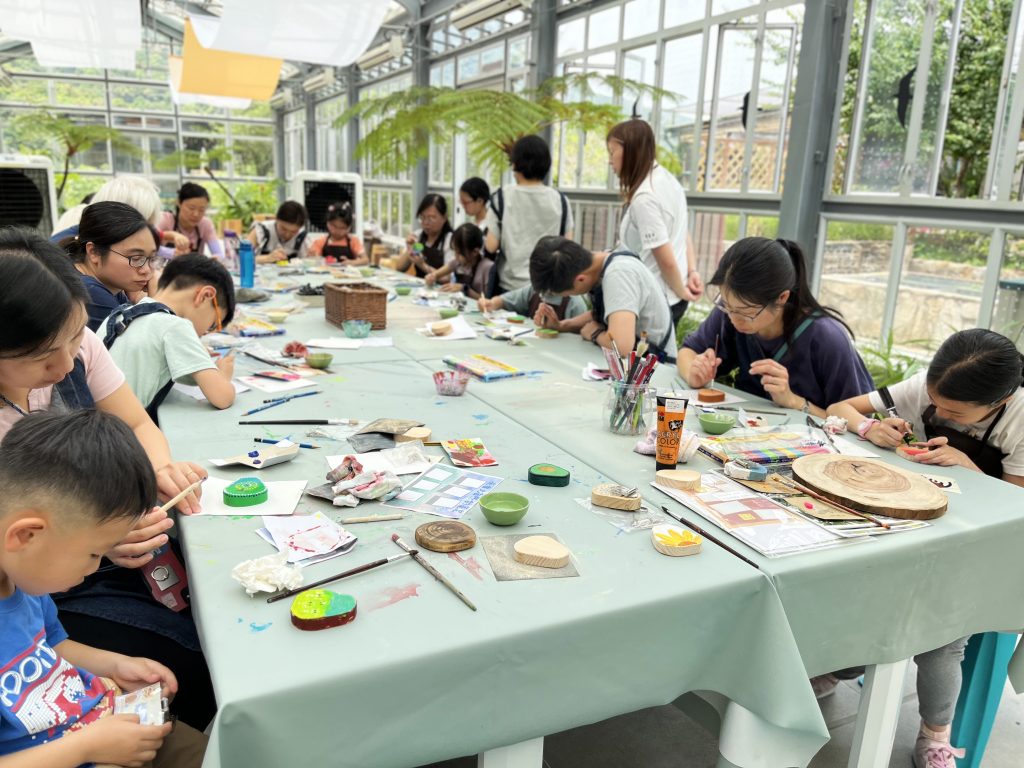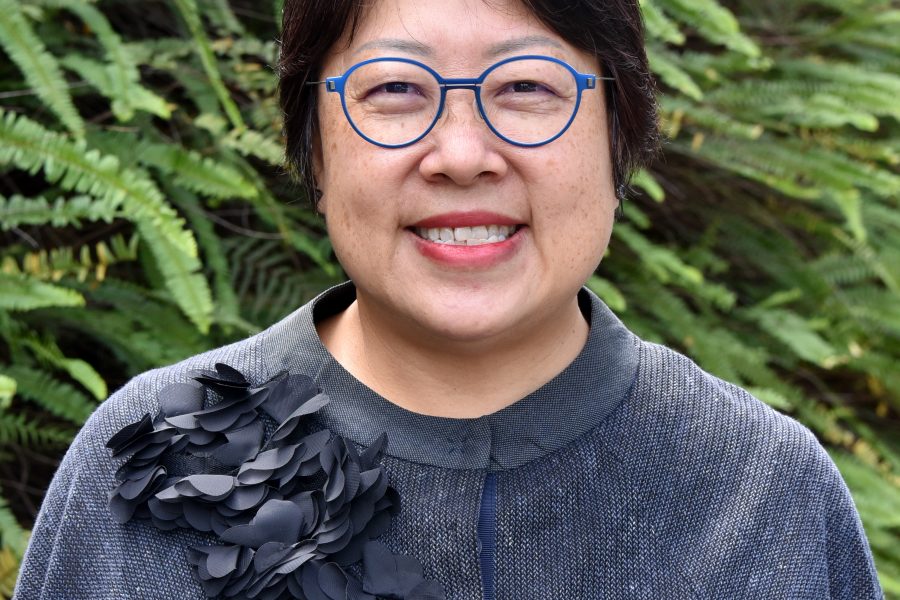The towering skyscrapers dominating Hong Kong’s urban landscape give the impression of a concrete jungle. However, nature is never far away – just a half-hour drive from any district in the city will take you to an expansive country park. Josephine Woo, Head of Holistic Education Department at Kadoorie Farm and Botanic Garden, knows that many Hong Kong families lead busy lives, with both adults and children spending at least five days a week confined indoors. This leaves little opportunity for them to access the open, boundless outdoor spaces where they can freely observe the sky and clouds above. Josephine urges parents to put aside their daily anxieties and venture into the great outdoors with their children to discover the art of slow living.
We are all part of nature
Kadoorie Farm and Botanic Garden (KFBG) was established in 1956 by the Kadoorie Agricultural Aid Association (KAAA). Nestled on the northern slopes of Tai Mo Shan, it spans an impressive 148 hectares. Within its bounds are a bubbling stream, a lush forest, rolling hillsides and vegetable terraces – all ablaze with the vibrant flora of the changing seasons. KFBG also serves as a vital sanctuary for many of Hong Kong’s native plants and endangered animals, making it an invaluable natural treasure trove in our city.
KFBG has evolved from its original purpose of providing agricultural aid to farmers in need of support to help them lead independent lives, to become a hub for science-based species conservation and ecosystem restoration. Today, it serves as a precious natural sanctuary where the public can engage with nature through its many wildlife exhibits, themed gardens and vegetable terraces. Through its multifaceted programmes in nature conservation, holistic education and sustainable living, KFBG strives to rebuild a harmonious connection between humankind and nature.
Josephine believes KFBG’s abundant natural resources make it an invaluable classroom for children. Through a diverse array of holistic, hands-on educational activities, children can gain insights that extend far beyond what books, texts and images alone can provide. Not only do we learn where our food comes from, but we are also reminded that we are all intrinsically part of nature. Caring for nature is akin to caring for ourselves – it is all about coexistence and mutual respect. “Our gardens’ vegetables and gourds respond differently to the rainy summer weather,” Josephine explains. “While the leafy greens may not thrive, the gourds tend to grow particularly lush as they soak up the plentiful moisture. We can use our vegetable plots to teach children about agriculture and food sources. By showing them the rhythms and patterns of the seasons, we can encourage them to eat more locally grown, in-season produce.”

Encounters” activity in KFBG to offer visitors a close encounter with animals.
Family strolls open up a world of engaging conversations
KFBG offers visitors the opportunity to immerse themselves in the wonders of nature throughout the year. KFBG boasts an incredible diversity of flowers, produce and wildlife each season. For instance, many guests visit KFBG during the Chinese New Year holiday in January and February to admire the vibrant enkianthus and cherry blossoms. KFBG is also a vital sanctuary for certain plant species, such as native orchids, that struggle to survive in the wild due to issues like pollution and over-harvesting. The rich floral scents at the farm have attracted a wide variety of butterfly species, which can be spotted flitting around in the Butterfly Garden and the slopes below. Visitors may even encounter less common urban wildlife, including frogs, snakes and bats. Since its establishment in 1994, KFBG’s Wild Animal Rescue Centre has received and rescued over 70,000 wild animals. Some of these animals have even become ambassadors for KFBG’s conservation work, allowing guests to learn about KFBG’s efforts in rescuing and protecting wild animals through their stories. During the “Nature Walk & Treasure Hunt @KFBG” Charity Event held every December, participants can get to know the local animal and plant species as they traverse the trails, whilst also enjoying the magnificent scenery of the Kam Tin and Tai Po countryside – making it an ideal family-friendly activity.
Josephine believes that parents should let go of their daily anxieties and take their children into nature more often, opening up a box of interesting conversations together. “When spending quality time with our little ones, we need to make a conscious effort to slow down and patiently explore topics that we can share and reflect on together,” she adds. “Nature provides us with such a wealth of free, enriching subjects for parent-child discovery and exploration. Some children who visited KFBG were curious about the unusual shape of the chairs made from recycled wood. Then, their mums explained how fallen trees can be repurposed into chairs rather than being thrown away. Even a simple topic like this can lead to discussions about the possibilities of sustainable living.”.
This year, KFBG has become the Ecological Education & Venue Partner for Lost Child Project Hong Kong, with the aim of helping children reestablish their connection with nature. Josephine states that during the pandemic, children have become accustomed to staying indoors and spending excessive time in front of their phones and tablets. She feels there is a need to reinvigorate their bond with the natural world. “The story of the divine bird created by Olivia Yan and her team beautifully conveys the idea that people have the free will to pursue their goals,” Josephine explains. “For instance, the characters in the story chose to take action to help the divine bird regain its strength. Caring for nature is also a choice. I hope this artistic experience will plant a seed in the participants’ minds, inspiring them to stretch, relax, run, play and discover themselves in the great outdoors. Not only can they get a boost in mental health, but they will also learn to coexist with nature.”

8-key Kalimba using recycled wood.
Sustainable living at our fingertips
While sustainable living is a key environmental focus for KFBG, the general public may not fully grasp the concept. Josephine points out that KFBG offers numerous examples of sustainable practices. For instance, when trees naturally wither or are felled by typhoons, the timber is recycled and given a new lease of life. “We shred the fallen trees and scatter the wood chips on the ground where they once stood, so the organic matter can nourish new plant growth. Alternatively, we convert the wood into biochar – a highly porous material produced at high temperatures that provides a habitat for organisms and can be mixed with soil to facilitate water absorption. The reclaimed timber is also used as raw material for visiting children to craft their own musical instruments, encouraging them to explore and express themselves through art.” Moreover, Josephine mentions KFBG’s Green Hub which promotes sustainable living through the adoption of a lowcarbon lifestyle. Established in the Canteen Block of the Old Tai Po Police Station, the Eat Well Canteen specialises in low-carbon cooking methods while preserving the site’s rich heritage. For example, their renowned Vegan Cheese Tofu is stained with nutritional yeast cheese powder, reducing the need for dairy products and thereby lowering carbon emissions. This allows visitors to enjoy delicious meals without consuming excessive energy. Parents can even seek advice from the Eat Well Ambassadors and learn low-carbon recipes as well as other sustainable living tips.
Connecting with nature to heal ourselves
With a passion for nature and hiking, Josephine is blessed with the means to destress by spending time in the forest. “I like to go to Kwun Yum Shan to meditate or reflect in the forest, and enjoy the quiet moments. Cultivating gratitude is truly a crucial lesson in mindful living.” Josephine recounts a personal experience of self-healing with the help of nature: “During a mindfulness course, the instructor asked me to write a letter to a tree near my home. Without much thought, I wrote a letter to a tree on the street corner and read it aloud to the tree. There are usually not many pedestrians around, but as I was reading to the tree, people began passing by and walking their dogs. It felt a bit strange but I carried on. Soon, I realised that the letter was meant for my late father, who had passed away six or seven years prior. It made me recognise that I had never fully processed the grief and pain of his passing. Through my connection with the tree, I was finally able to share my most sincere feelings. Thanks to the letter, I felt that I had let go of a little more of my sorrow. Because of my busy lifestyle, this unhealed wound had gone unnoticed. The importance of mental health is so widely recognised nowadays, and this experience of forging a connection with nature has reminded me to tend to my unresolved emotional wounds.” She believes there is an abundance of relatively simple ways to balance the stresses of life, such as connecting with nature, and that many people can benefit from trying them.
To tackle nature-deficit disorder in children, renowned theatre artist Olivia Yan has joined hands with artists, nature education experts and mental health experts to launch “ÉLAN Eartheatre – Regain The Lost Wings”. Designed for children aged from six to 12, this one-and-a-half-year programme aims to awaken our awareness of nature, life and the environment as well as restore our physical, mental and spiritual health by bringing “Earth Art x Environmental Friendliness x Immersive Theatre” to life. As the Ecological Education & Venue Partner of this groundbreaking programme, KFBG not only cooperates with numerous nature and art workshops for children, but will also be staging Hong Kong’s first-ever mega environmental immersive theatre festival in December. Participants are invited to immerse themselves in the story of “Regain The Lost Wings” while exploring environmental and artistic activities across different areas, followed by a large-scale parade with a giant model of the divine bird in the story as it returns to its nest and gives birth to vibrant colours. Please stay tuned by following the Facebook page and Instagram account of Lost Child Project Hong Kong.

